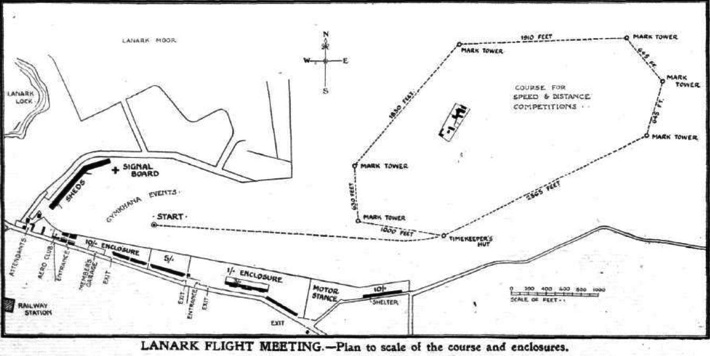Scottish International Aviation Meeting
Lanark, UK, August 6th - 13th, 1910
Lanark, UK, August 6th - 13th, 1910
The Lanark airfield

The racecourse itself was only used for the take-off and dispatch delivery contests during the aviation meeting. The speed and endurance events were held on a 1.75 mile (2.816 km) seven-pylon course marked up east of the airfield, encircling the Springbank farm. Grandstands and other conveniences were already in place, and the site offered almost unrestricted space for spectators. The downside of using an existing racecourse was that a lot of fencing and other obstacles had to be removed, but otherwise the airfield only needed minor levelling work. The marked course, on the other hand, passed over hills and valleys and was partly surrounded by forests, so it was affected by difficult wind patterns. This also meant that less than half of the course was visible from the grandstands.
A line of hangars was built at the western end of the field. In contrast to several other meetings, they were solidly built and covered with corrugated sheet metal. The location of the hangars was, however, a disadvantage, since it meant that the pilots would most often have to take off with the prevailing westerly wind from behind, but they had a long take-off straight at their disposal before reaching the timing tower.
A flying school was opened at the airfield in May 1911, operated by W. H. McEwen with a single Blériot. There were regular flights from the airfield during the second half of 1911, but it appears there was little activity during 1912, and McEwen and the flying school moved to Hendon.
The racecourse, which mainly hosted minor events, closed in 1977, but the site is largely unchanged and some installations are still left.

The plan of the airfield. Click  here
for a bigger version. (1)
here
for a bigger version. (1)
 here
for a bigger version. (1)
here
for a bigger version. (1)

The racecourse before the
meeting. (2)

The view of the line of hangars
from the main grandstand. (2)

A view of the crowded enclosure,
with Dickson's machine pasted in. (3)

The board where the results were announced. (4)

The railway station that was built especially for the meeting. (4)
Too see more details, open the maps in Google Maps by
clicking the "full screen" symbol at the top
right of the menu bar!
 Back to the top of the page
Back to the top of the page
